Arrests.org Official MN – Search Minnesota Arrest Records
Discover Minnesota’s criminal records and daily arrest reports across every county in MN through official channels in just minutes.
Navigating the Maze of Minnesota Arrest Records and Criminal Proceedings
Thanks to Minnesota’s and federal open record laws, these records are accessible to everyone for any purpose. However, locating Minnesota arrest records and criminal proceedings can be overly complex due to varying processes across different agencies and record types.
Streamlined Access with Minnesota Records Page
Minnesota Records Page aims to simplify this process with our comprehensive how-to guides, ensuring quick and easy access to any public criminal record. With our guide, you’ll uncover:
- Online Inmate Rosters: Featuring recent or daily arrests, along with contact details for arresting agencies.
- Criminal Records: Accessible through courts and law enforcement agencies.
- Arrest Warrants, Probation, and Parole Status: Get the information you need.
- Sexual Predators in MN Neighborhoods: Stay informed about your community.
- Prison Records: Explore records for Minnesota state prisons and federal penitentiaries.
Empower Yourself with Knowledge
Additionally, citizens will gain insights into background checks for personal or professional purposes, the process of bailing someone out of jail, expunging records, and the ethical use of criminal and arrest records.
Click Here to Search this form: https://minnesota.recordspage.org/arrest-criminal-records/
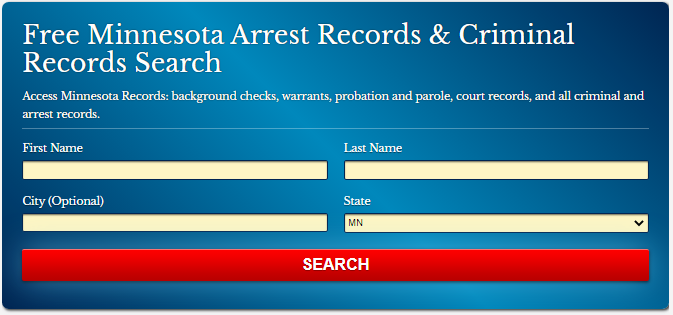
Accessing Public Criminal Records & Arrest Records: Minnesota
Minnesota classifies data as either private or public information. Private records are unavailable to the public and may require a court order to access them. These encompass juvenile records, all arrest information, and convictions over 15 years old. In contrast, public information, including offenses, convictions for 15 years, date of offenses, probation information, and the place of confinement, is accessible to anyone.
Legal Framework for Data Access
The Minnesota Government Data Practices Act (MGDPA), along with other statutes and acts, regulates the access and dissemination of arrest and criminal records in Minnesota. The MGDPA mandates that accessed data be used for specific purposes, with legal consequences for misuse.
Freedom of Information Act (FOIA)
The Freedom of Information Act (FOIA) enables individuals to access data unless it threatens data usage. FOIA allows data usage for research, accountability of agencies, and lawful duties.
Protection of Juvenile Records
Minnesota Statutes §299C.095 categorizes juvenile records as private data, limiting access to the criminal justice system during trial courts, public defenders, and criminal justice agencies. Access may also be granted for background checks on employment or license applicants seeking to determine criminal history.
Ban the Box: Protecting Applicants
While criminal records are public in Minnesota, Statutes §364.01 and 364.10, known as “Ban the Box,” offer safeguards on their usage. These provisions aim to prevent discrimination against individuals with criminal histories in employment while allowing employers to review employees before hiring.
According to “Ban the Box,” employers cannot inquire about a potential employee’s criminal history until after an interview or a conditional job offer. Extended criminal background checks can be conducted once a conditional job offer is made.
In Minnesota, reporting violations of “Ban the Box” is possible through the Ban the Box Submission Form to the Minnesota Department of Human Rights.

Difference Between Criminal Records and Arrest Records in Minnesota
In Minnesota, criminal records and arrest records are related but distinct. This section highlights the disparities between these two types of records and their significance in various contexts.
The Role of Criminal and Arrest Records in Employment and Legal Proceedings
Employers and courts frequently rely on both criminal and arrest records for a variety of purposes, such as background checks, sentencing decisions, and probation evaluations.
Minnesota Arrest Records: What They Include
Minnesota arrest records encompass the following information:
- Name
- Mugshot (availability may vary)
- Age
- Gender
- Date and time of booking (sometimes noted as incarceration)
- Booking agency (typically the Sheriff’s Office)
- Booking ID/Booking number
- Court case number
- Housing agency (location of offender’s incarceration, usually county jail)
- Offense/charges
- Status
- Scheduled release date (if applicable)
- Actual release date (if applicable)
- Bail amounts
Minnesota Criminal Records: Comprehensive Information
Minnesota criminal records contain the following data:
- Name
- Date of birth
- Case number
- Date filed
- Case title
- Case type
- Case location
- Case status
- Citation number
- Judicial officer
- Charges
- Level of charge
- Statutes
- Disposition and date of disposition
- Offense date
- Community of offense
- Law enforcement agency
- Prosecuting agency
- Guilty pleas
- Fines and fees (if applicable)
Discovering Recent Arrests in Minnesota: A Free Resource
To learn about recent arrests in Minnesota, individuals can contact or visit their local Sheriff’s Office for free access to crucial information about arrestees’ charges, current status, and upcoming court appearances. The Minnesota Government Data Practices Act permits public access to arrest records without the need for consent. Interested parties can also obtain this information by checking county jail rosters or making a simple phone call.
Accessing Minnesota Arrest Records and Mugshots via County Sheriff’s Offices
Numerous Minnesota counties regularly update their websites with daily arrest information. Some, like Anoka County, offer an inmate arrest records search feature that provides inmates’ arrest details and mugshots when queried.
Unlocking a Wealth of Information in Minnesota Public Records
Many counties in Minnesota regularly update their websites with information about daily arrests. Anoka County, for instance, offers a convenient inmate arrest records search tool. When you use this feature, it provides you with comprehensive details about the inmate’s arrest, including a mugshot of the individual.

Aitkin County serves as a noteworthy illustration of a county that provides a daily jail roster instead of utilizing an inmate locator. The roster, depicted in the accompanying image, includes the names of inmates along with their associated charges, and each inmate is accompanied by a mugshot.
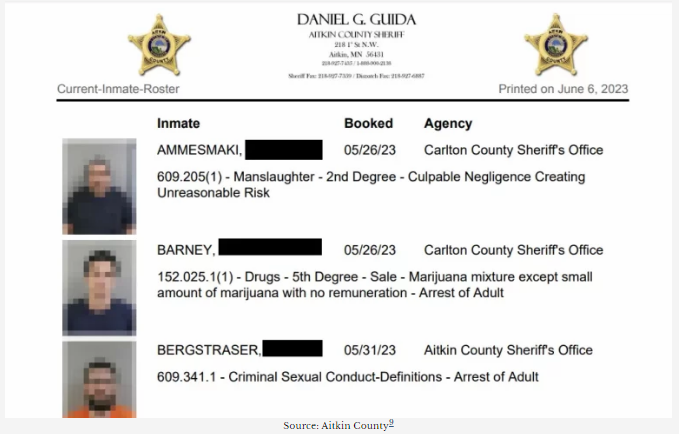
Prospective individuals may also consider a visit to or contact with their local Sheriff’s Office for additional information on an inmate whose arrest information is not currently accessible via the Internet. Typically, in the majority of Minnesota counties, arrest reports become accessible within 24 hours of the arrest.
The following table provides links to inmate locators or jail rosters for each Minnesota county, along with contact information for the county jail or the Sheriff’s Office. It also indicates whether the search tool or jail roster includes an accompanying inmate mugshot. This information can be utilized to determine whether someone is currently incarcerated in Minnesota.
Accessing Criminal Records in Minnesota: A Guide
If you’re looking to obtain someone’s criminal record in the state of Minnesota (MN), there are multiple avenues available for you to explore. Below, we provide an overview of government agencies that can assist you in accessing these records, with more detailed explanations to follow.
One method for accessing criminal records is through the Minnesota Court Records Online (MCRO). MCRO provides access to a wide range of public case records and documents, including valuable criminal records.
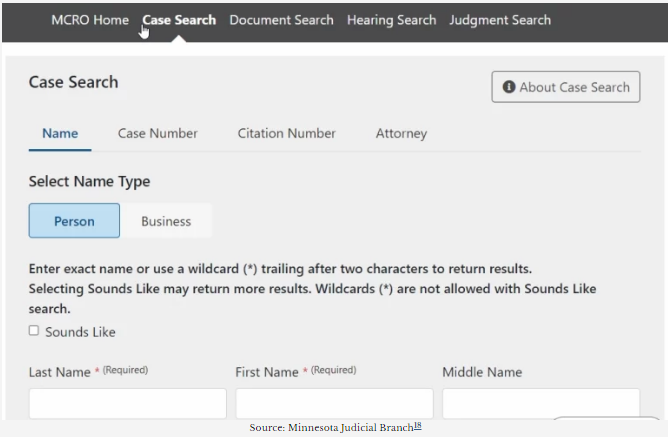
In Minnesota, individuals can access statewide public court case records through public access terminals located in each district courthouse. These terminals provide electronic access to court case records for those seeking information.
Additionally, individuals interested in obtaining criminal records in Minnesota can do so through the Minnesota Bureau of Criminal Apprehension (BCA). Court records can be a valuable resource for determining if a warrant list has been issued, indicating whether someone has been charged with a crime.
Here is a breakdown of how individuals can obtain public criminal records in Minnesota:
Online Access
Public criminal records can be accessed online through the Minnesota Public Criminal History Record Search website (website link provided). This online platform contains comprehensive public criminal history data.
Visit the Bureau of Criminal Apprehension (BCA) Office
Individuals can also visit the Bureau of Criminal Apprehension (BCA) office to access criminal records and a mugshot database. This service is provided free of charge.
Use the County’s Court Case Access System
The Minnesota Judicial Branch offers an “Access Case Records” webpage that allows individuals to view county court records and check their availability in the online portal. To use this service, the inquirer should have information about the court file’s case number/file number and the names of the participants in the case. These details are necessary to search.
Access via Public Terminals
Public computer terminals at the Minnesota State Law Library and the “Find Your Court” search feature provided by the Minnesota Judicial Branch also allow access to court records. However, please note that there is an $8 fee for printing at the courthouse terminals.
By following these methods, individuals can obtain the information they need from public court and criminal records in Minnesota.

Explore Criminal Records in Minnesota Using the Minnesota Public Criminal History Tool
The Minnesota Bureau of Criminal Apprehension Criminal History System (BCA CHS), commonly referred to as the Minnesota Public Criminal History Tool, serves as the primary database for all criminal records within the state. This comprehensive people finder database grants individuals access to information regarding individuals who have been arrested and convicted of crimes.
Access to the Criminal Apprehension Criminal record repository is available to anyone at no cost. To initiate a search and ascertain whether an individual possesses a criminal record, the searcher must provide the offender’s first and last name, along with their date of birth.

Moreover, the Minnesota Rules Court within the Judicial Branch governs the accessibility of public court records, while the Minnesota Appellate Courts Case Management System (P-MACS) provides public access to court case records of the Minnesota Supreme Court and the Minnesota Court of Appeals.
In essence, when a case undergoes an appeal in trial courts, the appellate court examines the case to determine if any previous errors, mistakes, or issues warrant modification or reversal of decisions.
How to Obtain an Official Copy of Your Criminal Record in Minnesota
There are several methods for obtaining a copy of your criminal records in Minnesota:
- The quickest and most convenient option is to use the Minnesota Court Records Online (MCRO). Through MCRO, anyone can access the Case Search link to search for and print a copy of their criminal records.
- Alternatively, individuals can visit their local county sheriff’s office in person during regular working hours to request a printed copy of their criminal record. For example, the Ramsey County Sheriff’s Office operates a Crime History Unit where such requests can be made.
- You can also request a copy of your criminal record to be mailed to your address via US Mail. To do so, the Bureau of Criminal Apprehension (BCA) requires requesters to send a notarized Informed Consent form, signed by the person whose criminal record is being accessed. This form should include the correct spelling of the subject’s name and their date of birth.
- Another option is to visit the BCA headquarters with a signed Informed Consent form and include a payment of $15 in either cash, money order, certified check, personal check, business check, or cashier’s check enclosed in a manila envelope. Allow three business days to pick up the requested records.
If you prefer to send a request by mail to the BCA, enclose a $15 check as mentioned above. Additionally, include a stamped envelope with your address and mail the request to the following address:
Minnesota Bureau of Criminal Apprehension, Minnesota Justice Information Services – CHA Unit 1430 Maryland Ave E St. Paul, MN 55106
Anticipate receiving a response within approximately two weeks.
How to Determine if Someone Is on Probation or Parole in Minnesota
Finding out whether someone is on parole or probation in Minnesota is made straightforward by the Minnesota Department of Corrections (MNDOC). The MNDOC maintains Minnesota criminal records for individuals under the supervision of the Commissioner of Corrections.
To access information about someone on parole or probation, you can use the Minnesota Offender Search Tool. This tool allows you to search the parolee database using either their last name or an MNDOC offender ID number.
The following image presents data on the total number of probationers and parolees in Minnesota, comparing it with other states across the United States. Additionally, it provides information on the ethnicities of individuals under community supervision in Minnesota, including those on probation and parole.
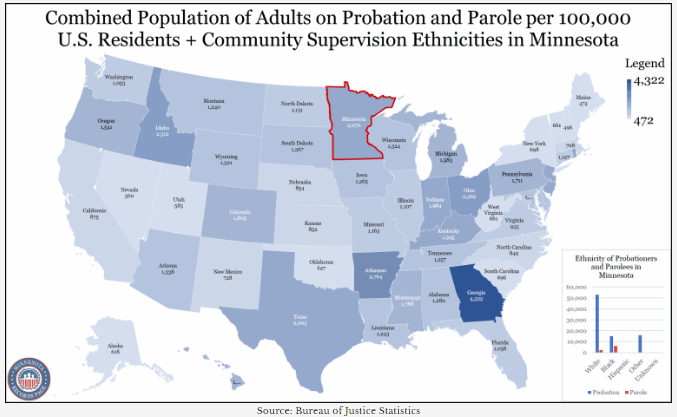
A sample of the probation search results is shown below, with those on probation shown as “under supervision.”
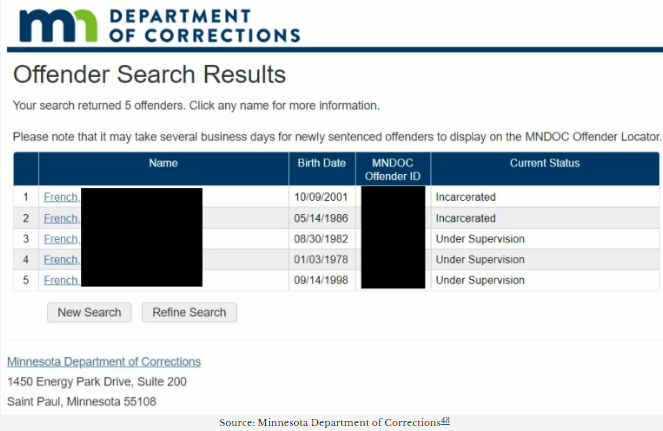
Supervision and Parole Oversight in Minnesota
In the state of Minnesota, the Community Supervision and Reentry Department is responsible for supervising probation, while the Board of Pardons holds authority over parole.22,23
Expunging Criminal Records in Minnesota: A Step-by-Step Guide
Minnesota provides the option for expungement of adult criminal records, as opposed to sealing them. The state recommends that individuals with a criminal record initiate the expungement process under the following circumstances:
- Case Dismissal or Acquittal: If an individual’s criminal case was dismissed or they were acquitted of the crime.
- Juvenile Convicted as an Adult: In cases where the individual was convicted as a juvenile but treated as an adult.
- Petty Misdemeanor with a Clean Record: If an individual was convicted of a petty misdemeanor and has not committed any other crime within two years.
- Gross Misdemeanor with a Clean Record: For those who were convicted of a gross misdemeanor and have maintained a clean record for four years.
- Non-Violent Crime with a Clean Record After Serving Time: Individuals who served time for non-violent crimes but have not committed any other offenses in the five years following their release.

Steps to Apply for Expungement in Minnesota
To begin the expungement process in Minnesota, you must follow a series of legal steps carefully. Each step ensures your petition meets the state’s requirements and increases the chances of approval.
Below is the first step you need to complete:
- Obtain the Expungement Packet
Visit the court and acquire the expungement packet of forms.
- Complete the Required Forms
Fill out all the forms and obtain any other necessary documents.
- File with the Court Clerk
Visit the court clerk and file all the expungement forms and other required documents.
- Pay the Filing Fee
Pay the filing fee where necessary.
- Notify the Prosecutor
Deliver another set of expungement forms to the prosecuting attorney. This is because, under Minnesota Laws, the prosecutor and the victims have a right to object to the expungement petition.
- Wait for Objections
Wait 60 days for the prosecutor and the victims to file objections against the expungement petition.
- Attend Court Hearing
Go to the court hearing. A ruling against the expungement will allow an appeal within 60 days. If the court grants the petition, all Minnesota criminal records will be expunged by all agencies that host them.

Initiating the Expungement Process: Why Legal Counsel Matters
Seeking expungement in Minnesota? Learn how a qualifying individual can start the process and why legal counsel is crucial for a successful outcome.
How to Locate Someone in the Minnesota State Penitentiary or Federal Prison
Discover two avenues to find an individual incarcerated in Minnesota: the Federal Bureau of Prisons and the Minnesota Department of Corrections.
Federal Prison Inmate Search
For those sentenced in federal court, utilize the Federal Prison Inmate Locator on the BOP website, your online directory to access the felony registry for federal prison inmates.
- Find by Number: If you possess the inmate’s BOP Register Number, enter it and initiate a search (see the first image below).
- Find By Name: Alternatively, use the ‘Find By Name’ option for your search.
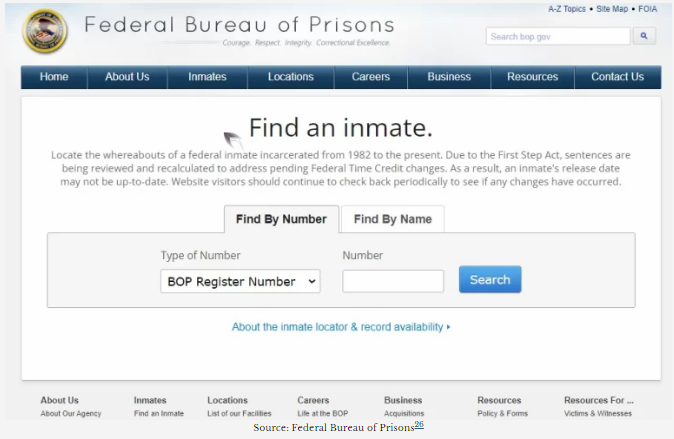
To ‘Find by Name,’ the inquirer must search by entering the inmate’s first, middle, and last name, followed by the inmate’s race, age, and sex, as shown in the second image below.

Minnesota (MN) State Prison Search
If you’re looking for someone in a Minnesota state prison, you can use the Offender Inmate Locator Search Tool provided by the Minnesota Department of Corrections (MNDOC) website.
This tool provides two search criteria:
- Search by Name: Enter the name of the offender you’re looking for.
- Search by MNDOC Number: Enter the MNDOC number of the offender.
The search results will provide information about the offender, including:
- Name
- Date of Birth
- MNDOC Number
- Offender’s Status (whether they are incarcerated or under supervision)
Additionally, you can find further details such as the offender’s mugshot, date of sentencing, and details of crimes committed.
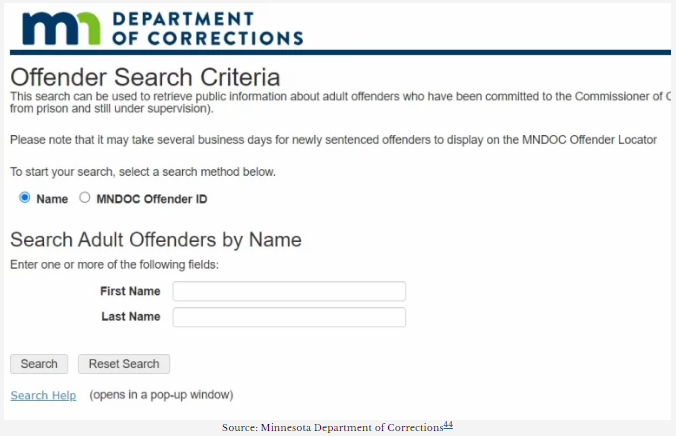
Executing a Minnesota Arrest Warrant Search: A Step-by-Step Guide
Searching for arrest warrants in Minnesota involves multiple steps that vary by county. While there is no centralized database, many counties offer both in-person and online options to access warrant information. Below is a step-by-step guide to help you get started.
- Determine the County of Interest: To begin a Minnesota arrest warrant search, it’s crucial to understand that warrant information is not maintained at the statewide level. Instead, it is available on a county-by-county basis. You’ll need to identify the specific county where you suspect the warrant may exist.
- Utilize Local County Offices: One way to find out if there’s an active warrant in Minnesota is by contacting the local county offices. These offices often maintain up-to-date warrant records. You can either visit the county offices in person or contact them by phone.
- Visit the Clerk’s Office: Another option is to visit the clerk’s office in the relevant county. Clerks may have access to warrant information, and they can assist you in your search.
- Contact the Sheriff’s Office: Reach out to the Sheriff’s office in the county of interest. They are responsible for law enforcement and may have information about active warrants. You can inquire about the existence of a warrant by phone or in person.
- Check the County’s Official Website: Many Minnesota counties provide online access to their warrant records. For example, Ramsey County offers an online warrant search feature. You can access this information from the comfort of your own home.
- Online Warrant Search: If available, visit the official website of the county in question. Look for an online warrant search tool, which may allow you to search for active warrants using first and last names.
- Enter Names for Search: Once you’ve found the online warrant search tool, enter the required information, typically the first and last names of the individual you are searching for. This will help narrow down the search results.
By following these steps, you can efficiently execute a Minnesota arrest warrant search and obtain the information you need.
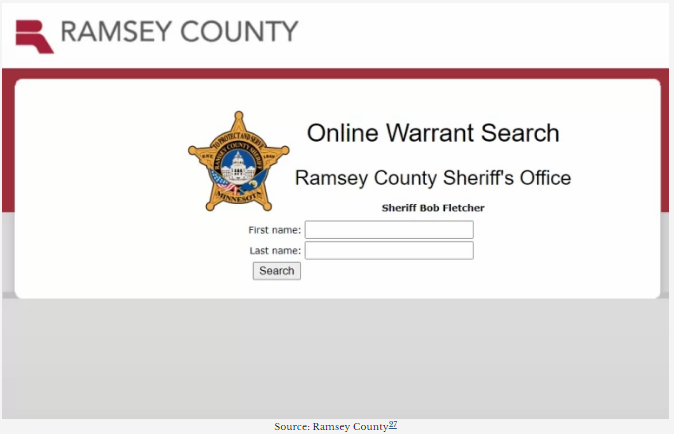
In contrast, Hennepin County has a warrant office where the inquirer can call and find out if someone has a warrant. This information is shown in the image below.
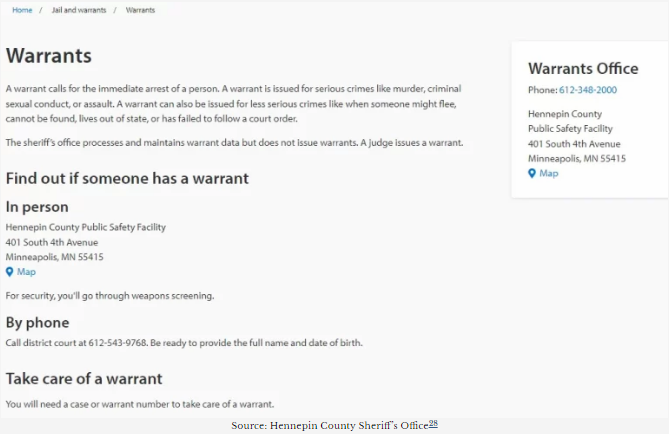
Determining the Existence of an Arrest Warrant
If you’re looking to understand how to access records in Michigan without any cost, you’re in the right place. Below are some frequently asked questions to guide you through the process and what to expect from the “Access Michigan Records for Free” program.
- Using PACER for Federal Warrants: To ascertain the presence of active federal warrants, individuals can utilize the Public Access to Court Electronic Records (PACER) case locator.
- Seeking Legal Representation: Inquirers may opt to engage legal representatives to check for active arrest warrants. However, this service typically incurs a fee.
- Requesting Warrant Information from the Sheriff’s Office: Alternatively, individuals can request an active warrants list from the Sheriff’s office, though some departments may not readily disclose this information over the phone.
- Utilizing Bail Bondsmen Services: Employing the services of a bail bondsman can also be an avenue to obtain information regarding issued active warrants.
Conducting Background Checks in Minnesota
Individuals can conduct background checks for various personal reasons, including assessing friends, acquaintances, and business associates. Furthermore, other entities may perform background checks, including:
- Employers on their employees.
- Firearms Licensing Agencies.
- Adoption Agencies.
- Child Protection Services.
Minnesota offers two types of background checks, namely Level 1 and Level 2:
Level 1 Background Checks: Level 1 background checks are name-based, state-only checks encompassing an applicant’s local or state criminal record and employment history. Additionally, these checks may include scrutiny of an applicant’s presence in the national sex offender registry and their credit history.
Level 2 Background Checks: Level 2 criminal background checks utilize fingerprints to investigate an applicant’s criminal history, including a comprehensive FBI criminal background search. These checks are typically conducted for individuals working with vulnerable populations, such as the elderly, children, or those in the healthcare sector.
In Minnesota, access to criminal records is limited to 15 years after the completion of a sentence and does not include private, confidential information or federal offenses.
Conducting a Background Check in Minnesota
To conduct a background check in Minnesota, follow these steps:
- Minnesota Department of Public Safety: The Minnesota Department of Public Safety serves as a repository for criminal records. Applicants must submit a notarized informed consent form in person or via mail after applying for a criminal history record.
- Minnesota Judicial Branch: The Minnesota Judicial Branch provides limited access to public court records. Online criminal records do not reflect cases with pending charges or cases without convictions. Detailed case information can be obtained from the relevant courthouse, but some files with confidential, private, expunged, or sealed information may remain inaccessible.
Navigating and Searching the Minnesota Sex Offender Registry
Minnesota is not part of the National Sex Offender Public Website (NSOPW) due to the absence of geographic coordinates for addresses. Only states with such information can be searched on the NSOPW registry.
The Minnesota sex offender classification spans from first to fifth-degree criminal sexual conduct. In first and third-degree categories, sexual conduct usually involves penetration, while second, fourth-, and fifth-degree classifications involve sexual conduct without penetration.
The Minnesota Department of Corrections website offers a statewide sexual offender registry search tool with four search criteria: city, county, name, and zip code.
To conduct a registered sex offender search:
- Begin the search by city, county, name, or zip code.
- The search results will display the sex offender’s full name and the date of their address change.
- Click the “Go” button to access comprehensive information about the sex offender, including their full name, date of birth, ethnicity, physical characteristics, release date, offense details, address, law enforcement agency contact, and aliases.
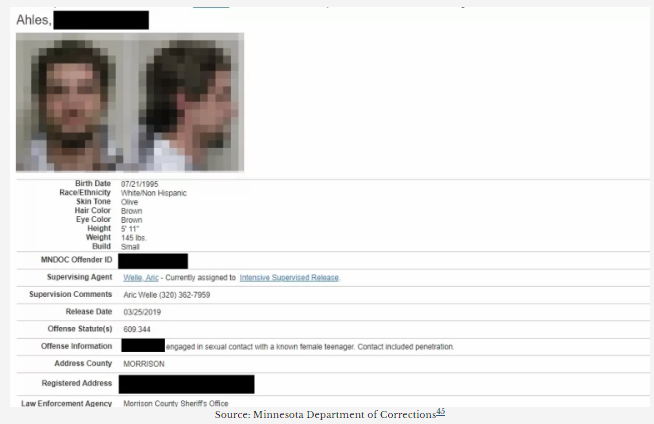
Minnesota Laws on Criminal Records, Arrest Records & Discrimination
Understanding how public records are handled in Minnesota is essential for anyone seeking background information. The laws outline what information is accessible and under what conditions. Below are the key types of records available under Minnesota law:
Access to Public Records in Minnesota
The Minnesota Government Data Practices Act (MGDPA) empowers individuals with the right to access a range of public records, including Minnesota arrest records, criminal records, arrest warrant information, and sex offender registries. It operates in parallel with provisions found in the Freedom of Information Act (FOIA), albeit with additional regulations governing the extent of access to these ostensibly public records.
Protection Against Discrimination
The Equal Employment Opportunity Commission (EEOC) safeguards against employment discrimination based on sex, color, race, and disability.36 Notably, the EEOC extends protection to individuals with prior convictions, ensuring they are not unfairly treated due to their criminal history.
Fair Employment Screening
Under EEOC jurisdiction, employers are prohibited from examining a prospective employee’s criminal history unless they have been shortlisted or offered a potential contract. This policy ensures that individuals with a criminal record are assessed based on their skills and qualifications, rather than their criminal past, which becomes a secondary consideration for the role.
Regulation of Credit Information
The Fair Credit Reporting Act (FCRA), a federal law, governs the collection and access to consumers’ credit information.37 The FCRA maintains strict standards regarding privacy, accuracy, and fairness in credit reporting, with enforcement duties falling to the Federal Trade Commission and the Consumer Financial Protection Bureau.38,39 The FCRA outlines the types of data credit bureaus can collect, as well as restrictions on who can access this information and the circumstances under which such access is permissible.
Protection of Privacy
The FCRA imposes several restrictions on accessing credit reports to protect individuals’ privacy, as the data is considered private rather than public information. These limitations extend to the use of criminal records for employment purposes.
According to the FCRA, non-conviction crimes such as arrests should not be reported after seven years. When hiring or reviewing client credit records, the requesting party is prohibited from seeking records dating back more than seven years.
Consumer Reports in Employment
Section 13C.02 of the Minnesota Statutes provides guidelines on how consumer reports can be utilized in the context of employment opportunities within Minnesota.40 This statute mandates that employers must obtain written consent from job applicants or employees before obtaining a consumer report.
Consent Requirements
It’s important to note that individuals do not need consent to conduct Minnesota criminal records checks for personal purposes. However, consent is a prerequisite for background checks conducted for professional purposes, such as employment, licensing, and housing. Applicants seeking access to Minnesota arrest records must also adhere to all relevant local and federal laws.
FAQ’s
Looking for answers about accessing Minnesota arrest and criminal records? Below are some frequently asked questions to guide you through the process.
These FAQs are designed to help you understand how to search public records in Minnesota quickly and easily.
Can I access Minnesota arrest and criminal records for free?
Yes, you can access some Minnesota arrest and criminal records for free through official government websites and databases. These records are considered public information and are typically available to the public.
How do I check arrest and criminal records for all Minnesota counties?
You can check arrest and criminal records for all Minnesota counties by visiting the official website of the Minnesota Judicial Branch or the Minnesota Department of Public Safety. These websites often provide access to statewide databases where you can search for records from all counties.
Are there any restrictions on accessing Minnesota arrest and criminal records?
While many Minnesota arrest and criminal records are public, there may be restrictions on accessing certain sensitive information, such as juvenile records or sealed records. Additionally, some records may require a formal request or authorization.
What information can I expect to find in Minnesota’s arrest and criminal records?
Minnesota arrest and criminal records typically include details about an individual’s arrests, charges, court proceedings, convictions, and sentencing. You may also find information about warrants, probation, parole, and sex offender registrations.
Are there alternative sources for accessing Minnesota arrest and criminal records for free?
In addition to official government websites, you can also check with local law enforcement agencies, county courthouses, and public libraries for access to Minnesota arrest and criminal records. Some third-party websites may offer limited free access, but be cautious and ensure the information is accurate and up-to-date.
